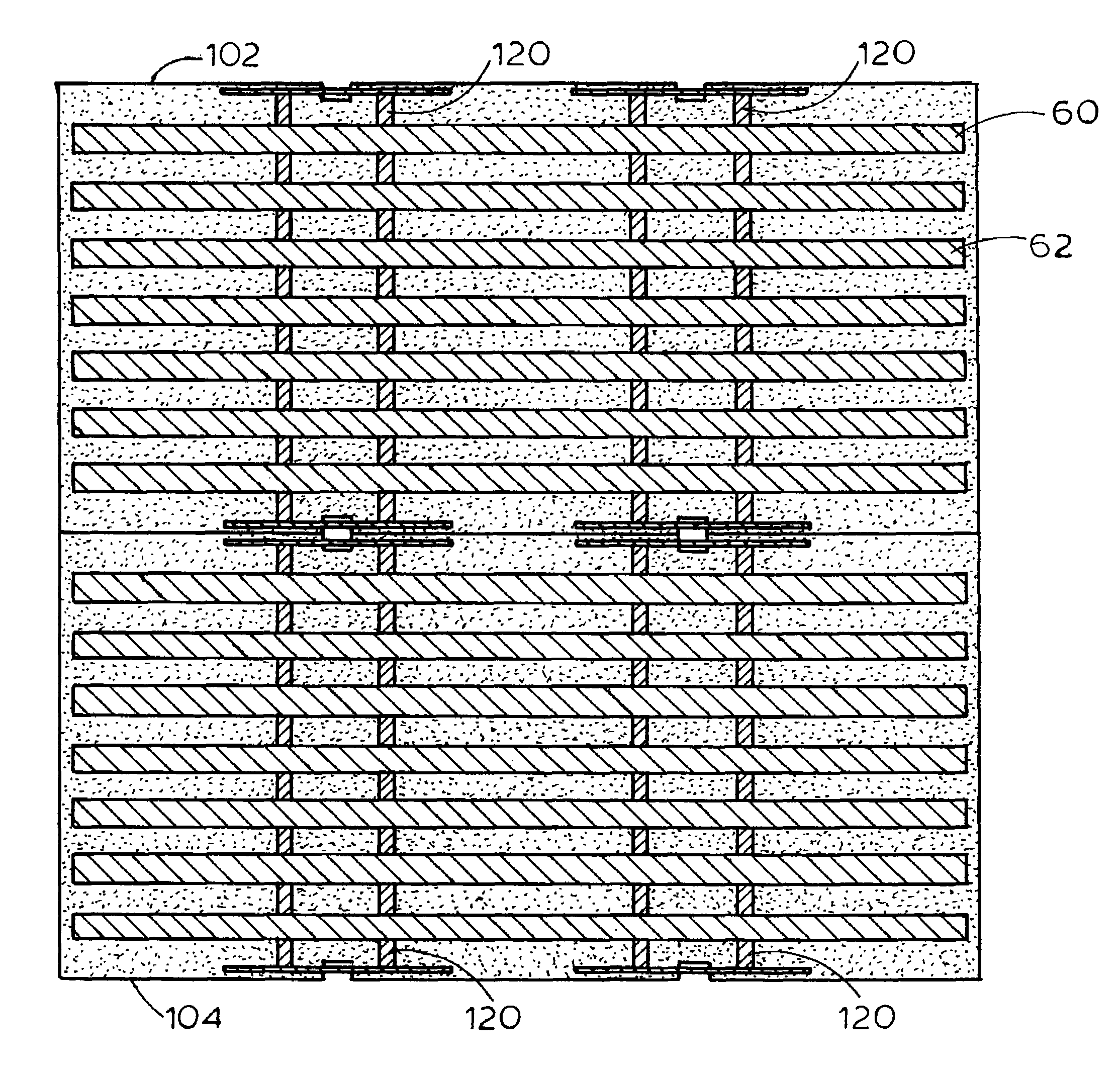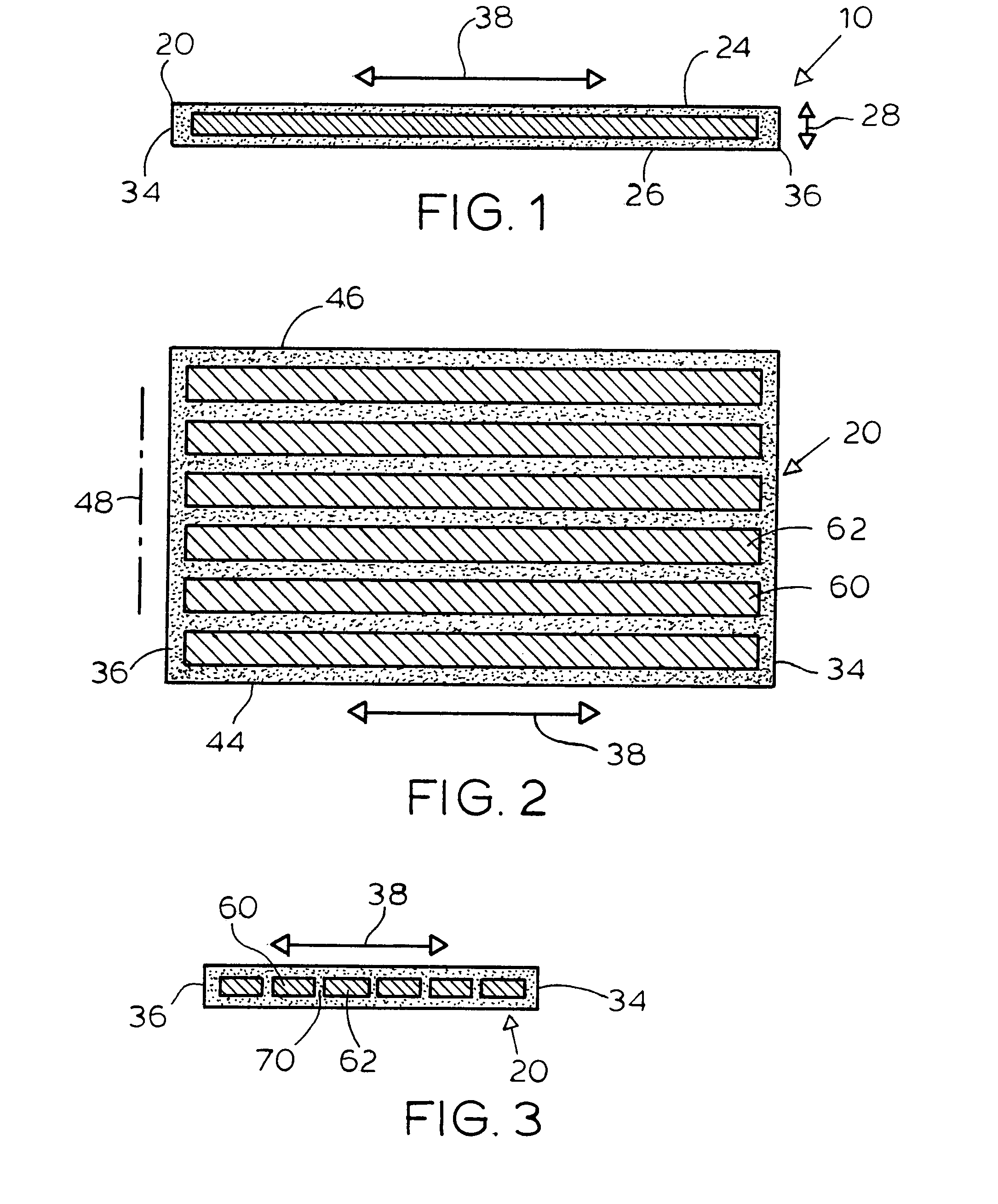Often these roads are located in areas that are subject to
extreme temperature ranges and must be left unattended for great lengths of time.
Accordingly, these roads are subject to extreme conditions.
The axle loading of a typical
heavy equipment truck is such that it is not feasible to drive it across a scraped or unprepared ground surface without experiencing sinking, jamming of the
truck, and similar impediments.
However, the nature of the industries causes the roads to
traverse extremely rugged and uneven
terrain.
Exacerbating the problem is the fact that many of the roads, once constructed, will remain unattended and unrepaired for great lengths of time.
Heretofore known roads have been deficient in balancing these competing objectives and the constraints placed on the roads.
Furthermore, there are frequently regulations associated with performing work in environmentally sensitive areas, which require the site to be returned to its original pristine condition when work is completed.
Such site restoration can become quite expensive and labor intensive.
Construction of a temporary road
bed using individual boards is costly and labor intensive.
The
heavy equipment that travels over the road bed often damages a large number of the boards so that the boards cannot be reused.
Disassembly of the road bed is also labor intensive and damages many of the boards not previously damaged during use.
Still further, roads formed of wood are subject to degrading, separation and the like.
If nails are used to connect boards, these nails can become dislodged and may damage the tires of vehicles traversing the road.
If the nails become dislodged, the boards can become separated which can damage the tires of vehicles traversing the road or even producing slick spots.
Still further, if the wood becomes damaged or nails fall out, elements of the road may remain after the road is removed thereby causing undesirable environmental damage.
If the boards become separated, vehicles may cause damage to the ground in the open areas, again causing undesired environmental damage.
Therefore, temporary roadways formed entirely of wood planks as taught in the prior art have many undesirable characteristics.
However, the prior methods of constructing a temporary road bed are generally expensive and
time consuming.
Although the preconstructed mats can reduce the time for constructing a temporary road, the cost of manufacturing the mats and the difficulty of moving and assembling the mats have limited their use.
Still further, these known methods do not produce a mat that is stable and which has a
good memory so it will return to its initial condition after supporting a very
heavy load, even a load as high as thousands of tons which is common in the construction and
oil drilling industry and even if the road is located in an area that is subject to extreme environmental conditions and which may be left unattended for great lengths of time.
Heretofore known mats are quite likely to become damaged and permanently distorted by such heavy loads and conditions.
A damaged or distorted mat must be replaced, which can add expense to the overall job through the cost of materials as well as the cost of labor, which is doubled because the damaged or distorted mat must be removed and then replaced.
An unreplaced damaged road may create a
hazard to vehicles and to the environment.
However, even with such an improvement, there is a continuing need to still further improve temporary roadway elements such as the one disclosed in the parent application.
While working in some conditions, the mat disclosed in this Canadian Patent has several drawbacks, for example, inter alia: the
wire grid inside the rubber tends to
cut the rubber when heavy loads are applied; the thermal properties of the steel wires are disadvantageous, especially in the extreme conditions in which the mats are to be used; the steel wires tend to move with respect to each other and with respect to the mat thereby creating
delamination problems and defining voids within the rubber; the steel wires are often flexible and do not have a good shape memory so that once flexed, the mat may not return to its original shape which had been designed for maximum effectiveness thereby creating problems for the overall mat with regard to the
terrain and with regard to load support features as well as exacerbating the just-mentioned problems; the steel of the grid does not have thermal properties that are advantageous to the
rubber mat; and the orthogonal arrangement of the steel wires in the mat disclosed in the Canadian patent is not the most efficient arrangement for supporting heavy loads under the environmental conditions in which the mat is used.
Furthermore, the preferred form of the mat disclosed in the Canadian patent includes two
layers of grids which may tend to exacerbate the problems associated with
delamination and void formation, the problems associated with rubber
cutting, and problems associated with varying thermal properties.
As an example of the problems associated with the mat disclosed in the Canadian patent, it is observed that movement of the steel wires in the mat may create voids in the mat which, themselves, will create problems.
For example, if the wires move either due to the application of a load to the mat or due to thermal conditions or due to uneven
terrain, they will tend to
cut the mat and form voids which will weaken the mat and may make the mat susceptible to
moisture invasion into the mat which will weaken the mat and may increase the size of the voids upon freezing.
A weakened mat may tend to damage the terrain under heavy loading.
Furthermore, a weakened mat may tend to break thereby vitiating the purpose of the mat.
 Login to View More
Login to View More 


